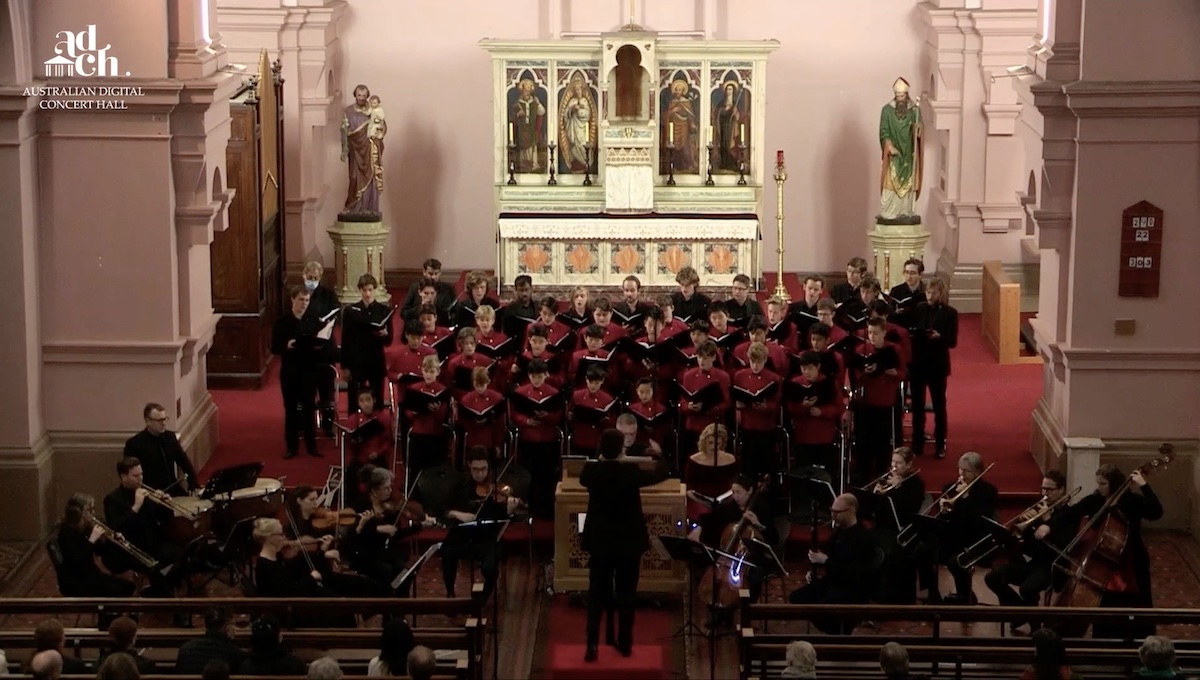
SEEKING NEW SINGERS – SIGN UP TODAY!
22 May 2022
NOW HIRING: SESSIONAL TUTOR
30 May 2022★★★★☆ ‘AUSTRIAN ENCOUNTERS’ - Limelight Magazine
Limelight Magazine's Steve Moffat took the time to review our first-ever livestream event on the Australian Digital Concert Hall.
We were proud to read his review published on the Limelight website on May 23.AUSTRIAN ENCOUNTERS (THE AUSTRALIAN BOYS CHOIR, THE VOCAL CONSORT & THE AUSTRALIAN ROMANTIC & CLASSICAL ORCHESTRA)
A neglected choral gem by Papa Haydn’s younger brother gets its first performance in 250 years, and what a magnificent piece it is. Reviewed on 23 May 2022 by Steve Moffat

A choral work by Joseph Haydn’s younger brother Michael that hasn’t been heard for 250 years has been unearthed and premiered in two stunning Melbourne concerts by the Australian Boys Choir.
Austrian Encounters by Australian Boys Choir, The Vocal Consort and Australian Romantic & Classical Orchestra, 2022. Photo from the ADCH livestream.
The original score of Litaniae Lauretanae in C Major, MH 71 was preserved in a cathedral archive and was recently digitised by Austrian scientist and musician Wolfgang Esser-Skala. Nicholas Dinopoulos, Artistic Director of the Australian Boys Choral Institute, got hold of a copy and the four-part work was given its Australian premiere at two performances, at St Mary’s Basilica, Geelong, and Sacred Heart Church, Carlton, in collaboration with the Australian Romantic & Classical Orchestra and four soloists.
Michael was five years younger than his famous brother Joseph, who guided him as a fellow chorister at St Stephen’s Cathedral in Vienna. Michael was more admired than his older brother as a singer, and Joseph even considered his sibling’s religious works superior to his own. He went on to serve for 44 years as Concertmaster in Salzburg.
“Michael Haydn has been relegated almost entirely to the ranks of the neglected, however he was very well respected during his time, composing a vast array of both instrumental and vocal music,” Dinopoulos said.
Of the concert’s program, which included works by Joseph and Mozart, he said: “We honour three composers who knew and loved one another.”
It featured 50 choristers – the boy sopranos in red tunics, the lower voices in black – and 13 Australian Romantic & Classical Orchestra musicians under Concertmaster Rachael Beesley with Michael Fulcher on chamber organ. Four excellent soloists – Suzanne Shakespeare (soprano), Emily Bauer-Jones (contralto), Henry Choo (tenor) and Stephen Marsh (baritone) – completed the line-up.
There were some balance problems on the livestream audio with microphones picking up the plosive sounds from the basses, which was distracting at times, and slight distortion in the higher register of the organ. That said, the four works were magnificently performed and the choir was in top form, led tightly and dynamically by Dinopoulos.
Mozart’s Litaniae Lauretanae in B Flat Major, K 109 opened the concert. The first of four litanies he composed in Salzburg, it was written when he was 15 years old, inspired by his first trip to Italy from which he had just returned. It is extraordinary to think that the composer was the same age as some of the boys in the choir when he wrote this lovely work.
This was followed by one of the most-loved choral works of the older Haydn, the Little Organ Mass. Shakespeare, taking the solo in the Benedictus, showed a bright and attractive coloratura and this was a highlight. The choir’s “amens” rang out at the end of the Credo and the fugal entries of the Hosannas were well handled.

After interval the Michael Haydn work was unveiled, and what a magnificent piece it proved to be. After an attractive introduction with organ weaving in between lively brass and strings, the choir enters for a jaunty Kyrie. Each of the three subsequent sections has a grandeur about the writing, aided by the three trombones and twinned trumpets and some virtuosic keyboard writing.
The Sancta Maria, marked andantino, provides a nice multi-layered contrast to the faster movements and the Regina Angelorum proves to be quite a spectacular showcase for instrumentalists and choristers alike, all delivered with admirable intonation and energy.
The Agnus Dei ends the work in a dramatic and majestic fashion and shows us why Mozart was such an admirer of the younger Haydn, some of whose sacred works influenced the Requiem, and why for many years some of Haydn’s instrumental music was wrongly attributed to the younger man.
This concert whets the appetite for more of Michael’s long-forgotten works just waiting to be rediscovered and revived.
Mozart’s Missa Brevis (Sparrow Mass) K 220 rounded off the concert in fine fashion, with its Hosanna section including the “chirping” bowing from the violins which give this work its nickname.
Incidentally this was one of the works that Franz Xaver Süssmayr turned to as a model for his completion of Mozart’s Requiem. Choo and Marsh were both superb in the Benedictus section.
The glorious Agnus Dei, with all four soloists combining beautifully, complemented by the 50 voices and strings, brass and drums, brought this excellent program to a close. Dinopoulos led a tight and well-judged performance, leaving those who had attended either live or digitally with some superb musical memories of this Austrian Encounter.
And there was a tasty bonus with Shakespeare giving a glowing performance of the melting Laudate Dominum as an encore.

